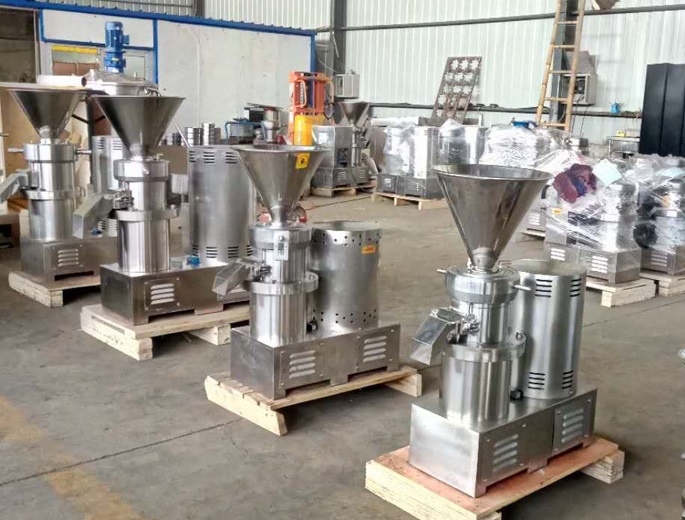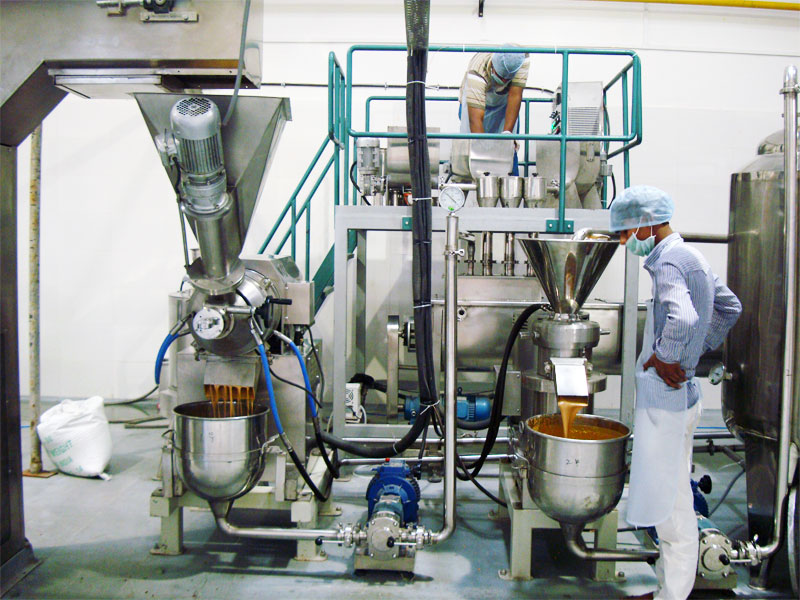Processing Technology of Sesame Paste
Raw Material Screening → Rinsing→ Roasting → Smoke and Dust removal → Grinding → Sterilization → Packaging → Finished Sesame Paste
1. Screening: Remove impurities in sesame, such as dirt, sand, iron filings, weed seeds and immature sesame seeds. screen
The cleaner you choose, the better.
2. Rinsing: Use water to remove the side-by-side mud, tiny impurities and dust that are about the same size as sesame. Rinse and soak the sesame seeds for 1-2 hours to allow the sesame seeds to hydrate thoroughly. The moisture content of soaked or sesame is 25% -30%. Drain the sesame seeds and stir-fry the seeds. If the sesame is still wet, stir-fry the seeds into the pan and peel easily. Soaking facilitates cell rupture. The sesame is rinsed and soaked, and the water penetrates into the inside of the intact cells, causing the gel to swell. After heating the fried seeds, the cells can be ruptured and the oil protoplasts flow out.


3. Roasting: Use our nut roasting machine to process sesame. At this time, the sesame has a large water content and will not be burnt; roast until about 20 minutes, the surface of the sesame bulges, and use simmered fire to stir. Use human or mechanical stirring to make the sesame evenly cooked. After roasted, pour 3% cold water into the pan, and fry for another minute. The effect of water splashing is to make the temperature drop suddenly, to make the sesame tissue crisp, which is conducive to grinding the sauce, and also makes the litter smoke rise with the water vapor. The fried sesame seeds are twisted by hand to produce oil, and they are brown in color. The sesame seeds have a crispy, uniform and ripe feeling. It is worth mentioning here that the sesame sauce for edible use should be fried with simmered seeds, while the sesame used for extracting small milled sesame oil should be made bigger and fried. The role of fried seeds is mainly to denature the protein, which is conducive to the removal of oil. When the sesame is fried to nearly 200 degrees Celsius, the protein is basically completely denatured, and the neutral fat content is the highest. After charring above 200 degrees Celsius, some neutral fats overflow and the fat content decreases. In addition, when stirring the oil, the coke skin may absorb part of the neutral oil, so if the sesame is too old, the oil yield will decrease. Stir-fried seeds produce scent substances, and only sesame seeds fried at high temperature have a scent. The oil produced after frying seeds at high temperature can retain rich flavor if the temperature is not increased.


4. Cleaning: Blow out the sesame seeds immediately, reduce the temperature, and lift away the dust, coke, and broken skin. Coke and shredded skin will affect the separation of oil and slag in subsequent processes and reduce the oil yield. If the sesame leaves out of the pot if it is not smoked in time to cool down, it may produce a burnt flavor, which affects the odor and color of the sesame oil.
5. Grinding: Use the stone grinder or peanut butter machine to grind the roasted sesame seeds into sesame paste. The finer the sesame sauce, the better. Put sesame sauce on your thumb nails and blow it away with your mouth. It is qualified that there are no obvious small particles on the nails. When grinding the sauce, add the ingredients evenly. It is strictly forbidden to air-grind. The temperature of the cooked sesame should be kept at 65-75 degrees Celsius. The speed of the stone mill is preferably 30 revolutions per minute. The grinding pattern of the stone mill is very fine. After grinding several batches of sesame, it needs to be chiseled once. The function of honing sauce: after frying the seeds, the internal oil and fat accumulate, and it is in a state of easy extraction (the viscosity of the oil and fat is also reduced). After grinding, it forms a slurry. Because sesame has a high oil content and a large amount of oil, this slurry is a suspension composed of solid particles and oil, which is relatively stable. It is difficult to separate solids and oil by standing. Therefore, it is necessary to use water to make solid particles absorb Baidu moisture, increase density, and separate itself. The honing sauce is required to be as fine as possible, which has two purposes: one is to fully rupture the oil cells in order to remove the fat as much as possible; the other is to make the water uniformly penetrate into the inside of the sesame sauce while stirring the oil, and the fat is completely replaced.

6. The sauce is heated to 95 ° C for 50 seconds for sterilization, and immediately after completion, it enters the canning process.
7. Canning and Sterilization: The four-rotation glass bottles and bottle caps are sterilized with steam or boiling water in advance, and the bottles are kept at a temperature above 85 ° C, leaving a slight gap, and sealed with a vacuum can sealing machine. You can also use our butter filling machine. After sealing the jar, place it in normal pressure boiling water for 10 minutes for sterilization. After the completion, the water shall be gradually cooled to about 37 ° C, and the moisture outside the jar shall be dried to obtain the finished product.